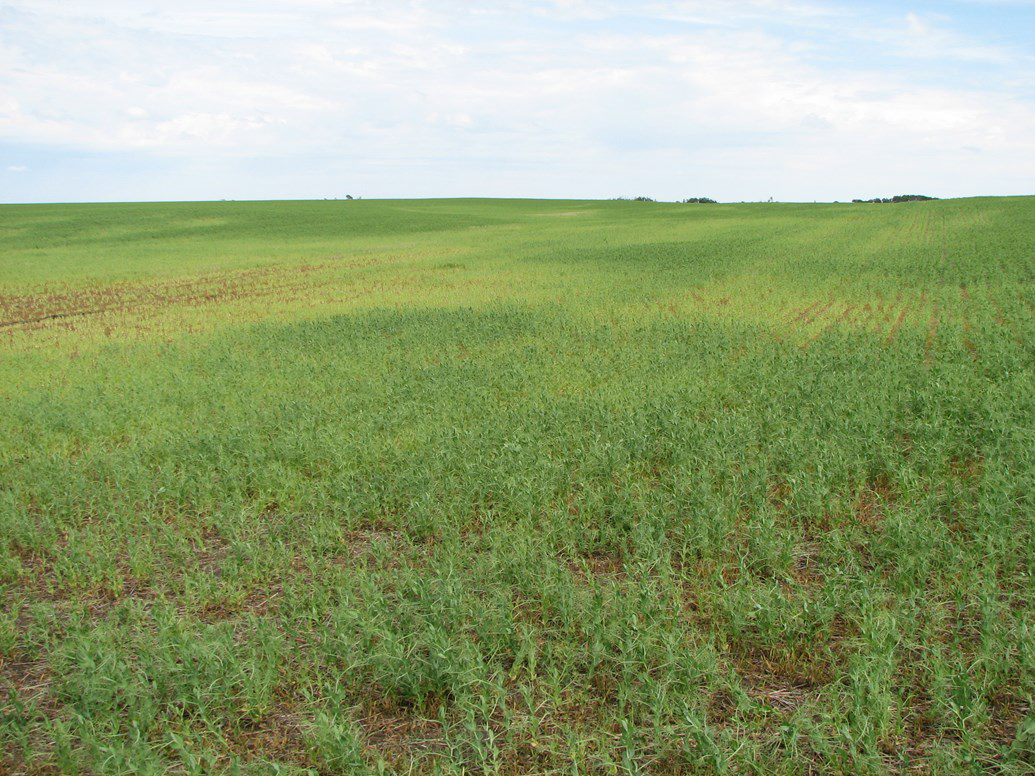Research Objective
To evaluate the impact of fall-seeded cover crops in combination with rotation crops on Aphanomyces root rot of pea, rotational crop yield and soil health parameters; to determine the rate of decay of Aphanomyces and Fusarium inoculum under standard rotations in Prairie soils, with and without cover crops and susceptible hosts; to assess whether there are any benefits or detriments of cover crops to canola and winter wheat crops when Brassica or cereals are used as cover crops.
Aphanomyces and Fusarium root rots were identified as the major root rotting pathogen of field peas and lentils in Alberta and Saskatchewan. Overall, 40-50% of pea fields surveyed were positive for Aphanomyces euteiches in 2015 2017, while 70-80% of fields were also positive for Fusarium root rot. Aphanomyces root rot avoidance by extended rotations away from a susceptible host (pea and lentil) is currently the only management option for Aphanomyces root rots while available seed treatments either have limited efficaciousness or have not yet been tested extensively under field conditions. The use of biofumigant cover crops, such as Brassica spp., as part of a rotation strategy has potential to increase the rate of decay of Aphanomyces oospores, thus shortening the length of time an infested field has to stay out of a pea or lentil crops.
Aphanomyces and Fusarium root rots were identified as the major root rotting pathogen of field peas and lentils in Alberta and Saskatchewan. Overall, 40-50% of pea fields surveyed were positive for Aphanomyces euteiches in 2015-2017, while 70-80% of fields were also positive for Fusarium root rot. Aphanomyces root rot avoidance by extended rotations away from a susceptible host (peas and lentil) is currently the only management option for Aphanomyces root rots while available seed treatments either have limited efficaciousness or have not yet been tested extensively under field conditions. The use of biofumigant cover crops, such as Brassica spp., as part of a rotation strategy has potential to increase the rate of decay of Aphanomyces oospores, thus shortening the length of time an infested field has to stay out of a pea or lentil crops.
The objectives of this project are to:
1) Evaluate the impact of a selection of cover crops on a subsequent season’s pea crop’s susceptibility to Aphanomyces root rot of pea and on soil health parameters;
2) Provide new knowledge on the rate of decay of Aphanomyces and Fusarium inoculum in Prairie soils, with and without cover crops and susceptible hosts; and
3) Assess the Aphanomyces and Fusarium inoculum potential of producers’ fields where cover crops are routinely grown and determine whether cover cropping practices help soil suppress these pathogens.
To achieve these objectives, a selection of Brassica and other cover cropping treatments were grown at four locations in 2019 and 2021, their biomass tilled or not tilled into the soil, followed by a pea crop in 2020 and 2022, respectively. Crops preceding the pea crop did not significantly reduce disease severity at any of the three trial locations (Lacombe, Lethbridge, and Saskatoon), nor was there any effect of tillage. However, pea yields were significantly increased when grown on faba bean, oats, and rye plots at Lacombe only. This may have been due to better growing conditions of the preceding crops at this site. Quantification of A. euteiches levels from soils from these trials was challenging, with most testing returning a negative result, despite high disease levels. For the soil cycling experiment, disease severity rapidly increased after three cycles of pea, with or without A. euteiches, in soils collected from both conventional and regenerative agriculture fields. This did not occur with lentils, and disease severity did not increase to a maximum even after eight cycles. In pea, regenerative ag practices may help suppress Fusarium root rot, but this was not observed for A. euteiches inoculated soils.
